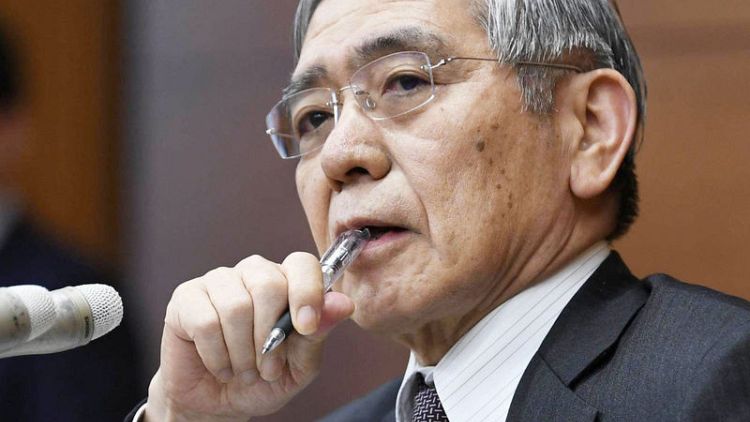By Leika Kihara
TOKYO (Reuters) - Japan's central bank governor has publicly flagged his readiness to ease policy if growth sputters, but sources say policymakers internally have little appetite for new stimulus, which could require a major policy overhaul and unsettle markets.
Bank of Japan Governor Haruhiko Kuroda on Thursday warned of heightening risks to the economic outlook and said the bank would ease if needed, brushing aside concerns it lacks policy ammunition to stave off another recession.
But the demerits of prolonged easing, notably the hit to financial institutions' profits from negative interest rates, and the BOJ's dwindling policy tool-kit have made many central bankers wary of ramping up stimulus, say sources familiar with its thinking.
It would take a global recession or a yen spike big enough to threaten Japan's export-reliant recovery for the BOJ to pull the trigger, they say.
"Unless there is a huge market-driven global shock, the BOJ will probably stand pat," one of the sources said.
"The BOJ needs to be more mindful of the cost of prolonged easing, which means the hurdle for additional stimulus is quite high," another source said, a view echoed by two more sources.
In the event of a big market shock, the most likely initial response would be to push out liquidity via market operations not just in yen but dollars, to ensure Japanese financial institutions do not face trouble raising dollar funds, the sources said.
A less likely measure if yen spikes are big enough to threaten Japan's recovery would be for the BOJ to cut rates, including short-term rates, which are already at minus 0.1 percent.
Market participants generally see the chances of the BOJ driving rates deeper into negative territory as slim, given the policy, which was introduced in 2016, has been hugely unpopular and blamed for narrowing margins of regional banks.
But Takahide Kiuchi, a former BOJ board member, believes rate cuts would be on the table if economic conditions are bad enough to justify action by the central bank.
"The adoption of negative rates was unpopular because the economy was doing well back then," said Kiuchi, who is now executive economist at Nomura Research Institute. "If the economy is in bad shape and the yen is rising, the BOJ won't be criticised for deepening negative rates."
Another response to such risks would be to offer stronger assurances to markets that its ultra-easy policy will stay.
The BOJ can do this by strengthening its forward guidance, or language laying out the conditions on how long it will maintain its massive stimulus, the sources say.
Under the current forward guidance, the BOJ pledges to keep rates at current low levels for an "extended period."
The stronger forward guidance could be accompanied by rate cuts or an increase in the BOJ's purchases of risky assets such as exchange-traded funds (ETF), depending on what kind of strain the economy is under, the sources say.
If such steps prove insufficient, the BOJ may be forced to take bolder steps such as abandoning yield curve control (YCC) and reverting to a policy targeting the pace of money printing, some analysts say.
That would allow the BOJ to ramp up bond buying again and help government finance big fiscal spending to reflate growth.
BOJ board member Goushi Kataoka has advocated a mix of bigger monetary and fiscal stimulus measures to reflate growth, though he remains a loner in the board in calls for more easing.
"The BOJ doesn't have many tools left to ease policy, so working with the government could be the only option left," said Shigeto Nagai, head of Japan economics at Oxford Economics.
"But that's risky and probably a measure of last-resort."
(Reporting by Leika Kihara; Editing by Sam Holmes)



